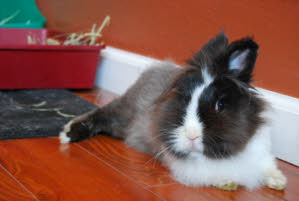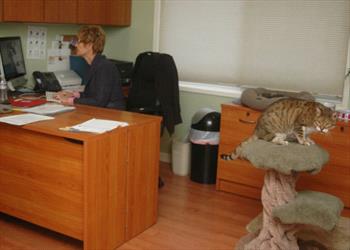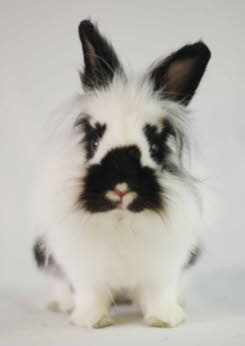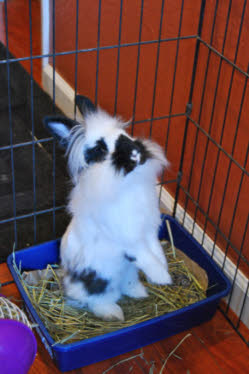
When I started training my first dog in 1985 I did everything my trainers told me but made slow progress. It wasn’t until years later, when I learned the scientific principles that guide learning in animals that I learned to train efficiently and to easily solve new training problems. Probably 90% of behavioral issues we have with our pets can be solved by understanding and applying the basic learning principles. (For more information see our new DVD: Pet Dogs, Problem Dogs, High Performance Dogs: How Science Can Take Your Training to a New Level). Here are some examples described by one of our summer college student interns, Celine Barbier.
What I Learned During My Internship
From August 13th to September 17th, I had the opportunity to work as an intern for Dr. Sophia Yin. I volunteered 29 hours of my time a week. Four of these hours were set up as behavior rounds in a classroom setting and dedicated to learning about behavior modification, developing problem-solving skills and mastering technical skills. The rest of my hours were spread out between helping out the CattleDog Publishing business, taking care of the various furred or feathered animals around and most of all working on behavior. I had volunteered previous quarters and I had gained a basic knowledge of learning theory but this internship really helped me become more comfortable in the science of behavior modification and taught me a few lessons along the way.
Lesson 1: When training a behavior, it is essential to define your goal and criteria as precisely as possible so the animal knows what you want
One of our first tasks was to work with the house cat, Dante, who was harassing our Operations Manager, Sharon, whenever she had food out. He would also constantly meow for attention. We wanted to train him that he would get kibble or treats only by lying on his bed and that only quiet sitting would be rewarded with attention. First, we had to define a criterion. We knew what our end goal was. However, we first had to break down the behavior into little incremental steps and start with behaviors that we knew the cat could perform.
So the first step was to have him sit on his cat tree quietly for 1 second. As soon as he was quiet for a second, we would hurry up and pet him for a few seconds as reward and then take our hands away. Then we tried to reward again when he was quite again for 1 second. Then we systematically increase the interval that he had to be quiet in order to get rewards. We had to make sure to be far enough away from Dante because otherwise he would rub against us while meowing and get rewarded that way for meowing. We thought we had it all figured out. Sadly, Dante disagreed with us. He would go on bouts of meowing for a while then be quiet. We would reward him with petting, since attention was a motivator. However, he would start meowing a lot again and we could not seem to increase the time spent quiet enough.
We tried different approaches. At first we felt that maybe we weren’t delivering the reward fast enough for him to understand that what was being rewarded was the quiet. We had positioned our bodies to be turned away from Dante when he was meowing and towards him when he was quiet. As a result, sometimes he was meowing again by the time we were turning to face him. We used a clicker as a bridging stimulus to try and close that gap but even with the click, he would start meowing before we got the treat to him. Plus, according to the Matching Law, the longer between the click and the reward the less value the reinforcement.
We also realized that some people working at the office were still rewarding Dante for meowing for attention by going towards him and talking to him, petting him, or playing with him.. We hadn’t told the people working there that Dante was in training, nor what they should do or refrain from doing when faced with the unwanted behavior. So, we explained that we wanted to train Dante to sit quietly on his tree and that they should remove their attention from him within 0.5 seconds every time he exhibited the unwanted behavior and that they should reward quiet behavior instead. They could remove the reward by pulling their hand away if they had been petting him or stay quiet if they had been talking to him. For the other behavior we were training, where we wanted Dante to sit quietly when Sharon had food out, we told Sharon to avoid giving food to Dante when he did this, but instead to only reward him when he was sitting on his tree quietly. If needed she could lure him from her desk to his tree with a Greenie® treat. She could give him one when he sat and additional treats at longer and longer intervals when he remained there quietly.
On day 3, when there was still no notable improvement in his ability to remain quiet we questioned our rate of reinforcement. We felt that Dante would get bored very quickly when we would remove our attention and start doing something else. In other words, he was not always motivated for our attention during our training sessions; hence attention was not a reliable reward in that situation. We switched to food-based reward. He would not take kibble so we gave Greenies® on the first day. Then we switched to kibble the following days. We were able to make this switch because we cut back on his food for a couple of days and only fed him the kibble that he was very willing to work for. His food motivation increased quickly.. As a result, when using food rewards we could get him to be quiet for longer intervals (over 20 seconds between treats) because we could keep rewarding continuous quiet but he would still have bouts of meowing in between these long bouts of quiet.
We knew that this training had only taken Dr. Yin 1–2 short sessions in the past. As a result, we knew something was wrong when after a week we had still not reached our goal of keeping Dante quiet for at least a minute or more. We finally thought about asking, Sharon how Dante was doing with her. Sharon told us that he did not bother her for her food anymore and would not meow like before.. So it turns out we had set a goal that was not relevant to what we wanted in real life. We thought we needed to get Dante to be quiet for a a minute or more for him to be quiet during real-life situations; however shorter intervals of quiet were good enough. Plus during all of our sessions he was getting rewarded for being on the tree rather than on Sharon’s desk, which is why he stayed off her desk.
Overall, during this training we learned:
- We needed to use the correct reinforcer and make sure Dante motivated for that reinforcer the entire time.
- We needed to only feed the kibble Dante is willing to work for if we want to get him to be consistently motivated for the kibble.
- We needed to set training goals that were relevant to real life rather than goals that based on theoretical ideas.
Lesson 2: Good Timing and Coordination is Critical in Teaching an Animal a Behavior
During my last week, we got to train a yellow Labrador who had a lack of impulse control. She would get overly excited when she met new people or people she liked and would consistently bark for attention. In order to fix that, we put her through the Learn to Earn program and taught her that only calm behavior would earn rewards. We taught her down stay, to lie down for petting and to sit for food. We practiced having distractions around, too, so she would have to stay calm in different contexts. We used the Treat&Train®, a remote-controlled food dispenser, to teach those behaviors.
One of the exercises was to have her sit at the door calmly for it to open and then, as I opened the door, I blocked her so she could not barge in. Once the door was open I would give her a treat to reward her sit and have her run and touch her nose to a target (a metal antenna with a red ball at the end). She would get an immediate reward from the Treat&Train® placed on her rug in the living room after touching the target. Then I would target her away from the rug and reward with the Treat&Train® so she would run to the rug again. After a few back and forth I would have her lie down on her rug and perform a down stay with distractions such as wiggling the leash or petting her, with treats coming frequently. Once the session was done, I would bring her back outside and start over.
While this sounds easy enough, I found myself struggling to perform all these tasks in an orderly manner. I had a bait bag with treats on my left side, a hands free leash on me, a target in my right hand and the remote control for the Treat&Train® around my neck. The first time I tried the exercise, I delivered the treat correctly at the door and targeted her into the house, but I didn’t have my fingers on the remote control and fumbled around a bit after she targeted. It happened again when I performed additional trials. She had already performed the behavior before so she knew to go to her rug anyways but if it had been another dog, it would have been let loose in the house frantically greeting people and it would have been hard to get it focused on me again.
Also, sometimes I would accidently press on the remote before targeting or press when she hadn’t actually touched the target. I would also press too long after she had touched the target, delivering too many treats. Sometimes I would not be fast enough to target again and she would wander around a little off her rug. Kellen, another volunteer, provided good suggestions to improve my coordination; but he too struggled with the exercise as well once he was training the behavior. My lack of skills caused the training to take more time as the dog took longer to calm down. After a few trials, I thankfully did not cause the training to regress and even got better myself with coordination and timing, so that I didn’t fumble around and the dog could be calm and more focused on me. Techniques may look easy but it is essential to practice them to master them!
Lesson 3: Interacting with an animal through training can help create a strong friendly relationship based on trust.
My first day at the internship, I was introduced to 2 long-haired rabbits, called Phoebe & Potter. They had been abandoned at the shelter and the office was fostering them with the task of turning them into more adoptable animals. They were each in a cage, Phoebe on top and Potter on the bottom, as neither of them were fixed. They were very jumpy and scared of a lot of things including petting, handling, noises, people just standing there, and other animals. The other interns and I started working on habituating them. We would take each of them out of their cage for a few hours and put them in one of the rabbit proof rooms at the office. We would have them roam around and get more comfortable with their environment. We would note their behavior while sitting in with them. Potter improved rapidly and soon we progressed to feeding him timothy hay pellets by hand and he would sit on people’s laps. He even learned the click-treat association.
Phoebe and a 3rd rabbit that we acquired, Picasso, progressed more slowly. One reason for the slow progression is that the rabbits were able to hide in the office rooms which prevented them from being exposed to the people who were quietly working in the room. When we figured this out, we changed our set up and put up X-pens and had them hang out there all day so that they were out and had people, dogs and cats passing by them to habituate them to the rhythm of the office. The result was that they were more exposed to people but at a comfortable level for them. They had constant access to hay but they could only get pellets and veggies when the interns were sitting in the pens with them. We spent 2 to 3 hours per day in there. Picasso started to trust us enough to even start taking pellets from our hands. We were classically conditioning him to associate us with good things by pairing the interaction with food.
Soon after, Phoebe followed. Instead of cowering when people passed by, they started running towards the noise and getting up on their hind legs to see who was coming towards them. When we were getting inside the pen they would even follow us around until we sat. Picasso liked climbing on my lap and soon he was ready for the click-treat association. Both rabbits improved dramatically once we removed their timothy hay pellets and started using them only for training. The day after we started doing this, they got much friendlier!
Once they would consistently eat treats on our presence we started working on the click-treat association. We used a clicker to make the clicking noise and then hurry up and get the pellet or lettuce to the rabbit’s mouth. We had 5 trials of 30 repetitions each and by that time Picasso knew the association. We thought it was pretty good but some rabbits can learn faster than others. For example, Potter had learned it in 2 sessions only. Next, we trained Picasso to touch his nose to a target. We would put a stick out with a green ball at the end in front of him, wait for him to touch it with his nose, click and reward. Then we started presenting the target a hop or two away and rewarding him when he touched it. When he knew that, we moved to teaching a specific behavior. We taught him to sit up with the target a few inches over him. Then we increased the criteria and raised the target higher and higher to have him stand taller. After a few tries, he started offering it by himself. We added a hand signal in as a visual cue and only rewarded when he performed the behavior after the hand signal was presented. This way he would know to offer the behavior only when prompted.
Before we taught the hand signal, Picasso would stand up on his hind legs anytime someone was looking at him and go up to people standing in the room and offer the behavior to them even though they had not necessarily trained him to do it. The fact that multiple people had been working with him and given him positive interactions made him more trusting and outgoing. He was even comfortable with the cat lying down next to him on the other side of the pen and would sniff him curiously. Lastly we taught him to take cards from our hands and he instinctively did it the first time the cards were presented. By the time we were done with him, he had turned into an outgoing rabbit, curious of his surroundings, interested in learning new behaviors and comfortable with people handling him.
Final Words
During this internship I learned to use my knowledge of classical and operant conditioning to help train rabbits to be happier and more comfortable around people and to train fun and useful behaviors in rabbits and a cat. I became more aware of how my actions affect the animal’s behavior and its training. I knew what to do and what to avoid in terms of body posture and timing when training which enabled me to perform training tasks more efficiently. I struggled with behavior problems and it forced me to be more resourceful and think outside the box in order to devise plans that would fit individual animals better. I got to train different species of animals and different behaviors. The most rewarding thing of all was to see an animal that I’ve trained perform the behavior taught to him perfectly. This internship was really worth all the work. I highly recommend it.








